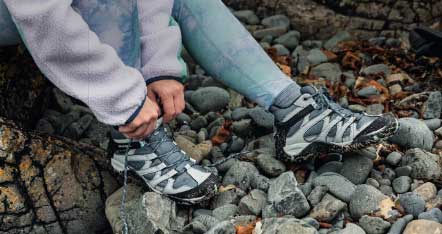How To Clean And Care For Your Walking Boots
For the adventure-seekers, off-road path takers, and Sunday walks to the pub goers - no matter your outdoor adventure, you need a trusted pair of walking boots worthy of every trip. Built to be durable, supportive, and sturdy enough for any conditions, your walking boots will see you through adventures for years to come - but only with the proper care and attention.
Whether it's leather, suede, nubuck, synthetic/hybrid, or an engineered mesh, read ahead and discover our step-by-step care guide to help keep your footwear performing longer.
Top Tips For Looking After Your Boots
Scrub Them Clean
Although it may seem like a chore, it's really important that after every walk (especially during muddy winter conditions) you take the time to lightly scrub off any mud, grass, grit, and dust that may have accumulated on your boots using warm water and a semi-stiff brush. For best results, we also recommend using a specialised performance footwear cleaner such as Nikwax Footwear Cleaning Gel or Granger's Footwear Gear Cleaner, before wiping off any excess residue with a damp cloth.
Absorb All Moisture
If your boots get really wet, stuff them with newspaper or use Absorba Balls to help draw out moisture, maintain their shape, and prevent the build-up of unpleasant odours. Try to resist the temptation to speed up the process by placing your boots next to a direct heat source like a radiator or fireplace as this can cause damage, warp the shape, and cause the upper of the boots to crack. Instead, allow them to dry naturally in a warm room or outdoors in dry weather away from direct sunlight.
Re-proof Regularly
Boots don't stay perfect forever. They need care, upkeep, and attention. To help keep your boots outdoors and adventuring for longer, you should seek to re-proof them every couple of wears in arduous conditions or when you notice the water has stopped beading on their surface. To do this, you need to know what your boots are made from. Boots are made from a range of fabrics, and each material needs a different product to help waterproof it. If you're ever in doubt about what your boots are made from, either check the manufacturer's website or ask our experts for advice next time you pop in-store.
Check For Wear
You should frequently check the soles of your boots for signs of wear. If you notice your boots are losing grip, you may want to think about having the sole replaced. If the boot uppers are damaged, this will likely compromise their waterproofing, and it may be time to replace them.
Material Types and Care Methods
Full Leather Boots
For full-grain leather boots, allow the shoes to dry naturally before using a cloth to apply Granger's G-Wax or the nozzle sponge on Nikwax Waterproof Cream. These help condition the leather, re-proofing it so it retains its waterproof qualities and help prevent it from drying out and cracking. To prevent leather boots from losing their shape, avoid excessively softening leather uppers by over-soaking in warm water or overusing softening and proofing products when treating them.
Suede / Nubuck Boots
For suede and nubuck boots, we recommend Beeswax-based treatments like Granger's G-Wax. This will nourish and protect all kinds of leather, maintaining performance and prolonging the life of your boots, however, do be cautious that beeswax treatments can change the appearance of suede and nubuck. To avoid this, we recommend using Nikwax Footwear Cleaning Gel, which protects and preserves the original texture of the leather. Apply an even coating to your boots while they are still damp, and then leave them for two minutes to allow them to absorb the treatment before leaving them to dry naturally.
Synthetic / Hybrid Boots
For synthetic boots, apply either Granger’s Footwear Repel Plus or Nikwax Fabric & Leather Proof while your boots are still damp after cleaning to help the proofer soak into the material, then allow them to dry naturally.
Shop Our Care & Repair Range
To check out more from our footwear care and proofing range, click below to shop the entire collection...
Related articles

Let us know you agree to cookies
We use marketing, analytical and functional cookies as well as similar technologies to give you the best experience. Third parties, including social media platforms, often place tracking cookies on our site to show you personalised adverts outside of our website.
We store your cookie preferences for two years and you can edit your preferences via ‘manage cookies’ or through the cookie policy at the bottom of every page. For more information, please see our cookie policy.





